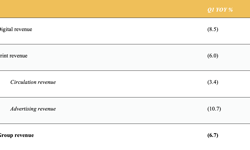The decline and prospective fall began long before the internet was invented. In February 1962, the Daily Mirror sold 4,247,598 copies a day. By February, 1982, that had shrunk to 3,300,742; by February 1992, to 2,875,439.
February 2012? Who can say, but if the year-end ABC scores are anything to go by, it won't be much over 1,000,000. The rot hasn't so much set in as begun to devour what's left of a once dominant redtop. And you can replicate that descent time and again. The Daily Express, down from 3,332,634 to 2,089,356 to 1,540,857 over the same twenty years at the end of the last century - and now to under 600,000; the People plummeting from 4,650,766 to 538,896 until James Murdoch killed the News of the World and gave kisses of life to his most immediate competitors. But then, the direst decline of all is right there in those same words: from 6 million plus in 1972 to nothing at all in 2012. No news, no world. For decline, read carnage.
Now, of course, newspaper statistics need to be taken with a barrel of salt. The Sun sold 2,535,362 in February 1972. It will sell rather more than that in 2012. So will the Mail: up from 1,681,024 to something a bit more respectable now. Yet let's not kid ourselves about swings and roundabouts. The Sunday Mirror, the Sunday Express, the Daily Star and more are all caught in a downward spiral. Traditional tabloid editors may still call themselves the "popular" breed, and despise their upmarket non-rivals as the "unpopular press" - but we are all on a slippery slope as we begin to slither towards print insignificance or oblivion.
What's gone wrong? It's tempting, in the midst of Lord Justice Leveson's inquirings, to talk crude intrusion, sleazy behaviour, hacking and the rest.
In short, to link circulation decline and declining standards of behaviour.
Yet the truth is much more complex than that.
The TV threat
What happened as the sixties began and the tabloids enjoyed their millions upon millions of readers (and profits)? Mass television - with competition between channels: choice and soaps. Coronation Street came to life in the last days of 1960. It, along with punchier news bulletins, signalled a profound shift for the tabloids. They couldn't run straight news lead stories any longer. What use was that if viewers had seen it all on ITN the night before?
And they couldn't break the story-telling spell of the Rover's Return, either.
Something else had to be done.
That something, undertaken quite consciously, was a vital shift of emphasis. Elsie Tanner and friends are part of our life, viewers swiftly concluded: but it isn't enough just watching Pat Phoenix on a flickering screen. She's real to us. So we want to know everything about her - who she's been married to, who she's sleeping with now, what she wears in bed?
Television itself won't tell us that. It's still too prim and starchy to indulge in incestuous gossip. But the demand for such gossip has never been keener. Here comes tabloid salvation!
And indeed it did. The Sun found salvation fast (whilst the more high-minded Mirror took time to adjust); the Mail, led by David English, moved with the zeitgeist; the redtops took on a scarlet tinge.
There was a step change in tone, style and subject matter. For a while, the Sun topped four million and acquired political clout as it grew. It wasn't a golden age. Think how the News of the World had been swimming around in a pool of eight million customers long before. But it was hugely profitable, and a huge boost towards swaggering confidence.
Yet then, of course, television changed again. Instead of two or three channels, Sky brought you two or three hundred to choose from.
Instead of getting your news at set times over tea and biscuits, the bulletins kept rolling 24/7. And, crucially, there was no primness about discussing celebrity private lives left. The E Channel and more like it oozed gossip hour after hour. MTV played the celebrity game for all it was worth. Channel Four instructed teenagers on sex. Channel Five instructed adults in similarly graphic detail. Breakfast TV had stars rolling round on sofas with your morning coffee.
The internet threat
Enter the internet: enter Hollywood tittle by the yard and X Factor tattle by the mile. Enter moving videos of girls stripping on demand: exit not just the mass audience for magazines like Nuts and Zoo, but any residual allure to the Sun's Page Three. What, their new stock in trade effectively destroyed, was there left for the redtops to do? Just more of the same: but this time without a safety net. The scenes you see in Lord Leveson's court room, the stories of criminality and corruption you hear, don't come from beyond a blue horizon. They are a sometimes instinctive, sometimes deliberately calculated, response to the thought of last orders in that famous old Last Chance Saloon.
If Leveson proposes what many more elevated editors and correspondents would prefer - a more draconian regime that effectively shuts the saloon forever - then we may be witnessing the end of any semblance of a mass market press, a retreat into a world where only ABC1s of a certain age have a paper that fits their self-image so that newspaper readership, as in France, becomes a thinner, weaker, more desperate thing. Take out the tabloids, after all, and only the Telegraph and (in modest, occasional ways) the FT makes a profit. The Guardian, Times and Independent between them can lose nearly £100 million in a bad year. This is a fragile, harassed industry in a fragile, uncertain world: and nothing about the growth of tablets, smartphones and apps brings any more certainty to bear.
At which point, perhaps, it's necessary for thousands of journalists and tens of millions of readers who sample their work every morning to take more sentient stock. Do you emphasise only decline and desperation in any current assessment? Or do you give fuller weight to what remains and what might yet be? The latest National Readership Survey figures go some way along that track. The Sun has well over 7 million readers every morning. The Mail has 4.5 million readers of its print edition (and another 4 million plus online). More people read the Daily Star than pick up a Times. The tabloids and redtops between them are sampled by over 19 million page-turning Brits every day - around three times what the more serious press can muster.
These are figures to ponder well beyond Lord Justice Leveson's courtroom.
No one can doubt that press standards are in the dock themselves, or that - either via a reformed Press Complaints Commission or perhaps some new semi-statutory body - the going is going to get far tougher for the tabloids. Their stock kiss and tell dishes are already off many menus. Pursuing paparazzi face a profoundly uncertain future if papers and magazines aren't allowed to buy their sleazier wares.
A European solution?
Shrewd media analysts - including my friend Jim Chisholm - note glumly that national newspaper sales are sliding faster in Britain than in any other major European country. Yet there is still a long way to go before readership penetration reaches the feeble levels of France, say: and there is still a devoted following of many millions that could yet help stage something of a rally.
Why is the European slide less calamitous? In general because major European papers are still rooted around big city communities - Frankfurt, Milan, Madrid, Barcelona, Rome. They are national, but they also have strong regional ties that help slow losses. They identify with their readers and their readers return the favour. But in the UK, there are few such links. Our regional dailies are weak, failing and overshadowed by the nationals. Farewell to the Liverpool Daily Post, here comes another weekly! But the nationals themselves don't provide compensating coverage (except of football).
We know that Liverpool turned against the Sun (over soccer tragedy).
We have few hints of any locality turning towards it. As the number of immigrants to Britain swells, little newspapers for ordinary working Poles, Pakistanis, Indians and the rest spring into life, but redtop culture shies away from claiming such readers as natural recruits. Read an average page of tabloid headlines - full of puns, TV catch phrases, and obscure WW2 references, to get the point. Readers from beyond our shores aren't welcome.
The game of biff, bang, wallop is the one played instinctively.
Is it truly the case, then, that only intrusion and celebrity revelation offer a way forward? Is there no other game in town? It's time, quite close to midnight, for some fresh thinking at last. Isn't Fakt in Poland a tabloid phenomenon of growth and success? Is Bild in Germany disappearing down quite the same hole as its onetime inspiration, the Daily Mirror? De Telegraaf in Amsterdam may still be a broadsheet, but its tabloid agenda helps it dominate the Dutch market.
As you journey round Europe looking for popular inspiration, you find designs that signal new thinking, not copycat tradition. You find agendas that are sometimes sensational but also bent on providing information. You find, in short, a mass market that refuses to die any time soon. Perhaps, as in Spain or Italy, it will huddle for safety on newsagents' shelves clad as glossy magazines, not papers. Perhaps it will follow the very convenient American model and head for supermarket display rather than paper boy delivery. But the appetite for putting issues and situations in human terms remains. It's the recipe that seems elusive.
Here's the post-Leveson challenge for Britain's "popular" papers, I think. You have an audience - a huge audience - that needs to be served. The internet is devouring you rather less voraciously than your competitors at the top of the market. You needn't, rationally, have plunged so low at the start of this century. There's much room left for you, and for what you can provide.
But the challenge itself couldn't be starker. The tabloids are being asked simply: What are we here for? And what they reply will define their continuing future, or none.










